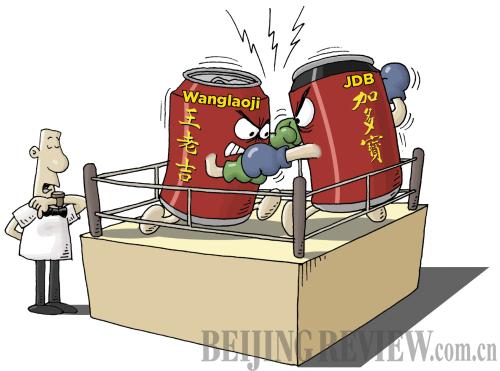|
 |
|
(CFP) |
When Yao Bo went to work one morning, he didn't expect to be stabbed in the face.
At a hospital in Suzhou, Jiangsu Province, Yao (not his real name), a sales representative for Guangzhou Wanglaoji Pharmaceutical Co. Ltd., recounted the dramatic incident to reporters. The sutured cut looked like a long centipede on the left side of his face. The person who slashed Yao's face was a worker surnamed Hao from the JDB Group, a competitor.
Representatives from Guangzhou Pharmaceutical and JDB that day were promoting their own tea brands in the same vicinity when events spiraled out of control and got violent.
Coming from a village in north Jiangsu Province, Yao had worked at Wanglaoji for only two months before he was attacked. Yao said he doesn't know the person who wounded him and holds no grudge. But he is cognizant of the reason he was stabbed: the resentment between JDB and Wanglaoji.
An herbal teashop called Wong Lo Kat (or Wanglaoji) opened in Guangzhou, Guangdong Province, in 1828 and was named after its founder Wong Chat Bong. In the ensuing decades the herbal tea was sold throughout south China, as well as Hong Kong, Macao and Taiwan, and then in Southeast Asia, the United States, Canada and France.
After the People's Republic of China was founded in 1949, Wanglaoji's herbal teashops in Guangzhou were incorporated into a state-run enterprise affiliated with Guangzhou Pharmaceutical Holdings Ltd. The Hong Kong part of the business, Hong Kong Wong Lo Kat (International) Ltd., is still owned and operated by Wong's descendants.
In 1992, Guangzhou Wanglaoji Pharmaceutical Co. Ltd. developed innovative herbal tea products using a century-old formula and packaged the products in paper packets and cans. This is the earliest example of packaged herbal tea in China.
In 1995, Guangzhou Pharmaceutical Holdings Ltd. leased the right to produce its red canned herbal tea to the Hong Kong Hung To Group. The JDB Group, affiliated with Hong Kong Hongdao Group, then started to use Wanglaoji's trademark for its red canned herbal tea, while Guangzhou Pharmaceutical Holdings Ltd. continued to sell Wanglaoji herbal tea in green paper packages. In 2000, Guangzhou Pharmaceutical Holdings Ltd. and Hong Kong Hung To Group signed another contract, stipulating that Hung To was allowed to use Wanglaoji's trademark until May 2, 2010.
In 2009, the sales volume of Wanglaoji herbal tea in the country reached 16 billion yuan ($2.52 billion), surpassing that of Coca Cola. Evaluated by Beijing Famous Brand Asset Evaluation Co. Ltd. in 2010, Wanglaoji had a value of 108 billion yuan ($17.03 billion), becoming the top-ranked beverage in China.
In April 2011 Guangzhou Pharmaceutical Holdings Ltd. filed an application with the China International Economic and Trade Arbitration Commission (CIETAC) to take back the right to use the Wanglaoji trademark. The CIETAC ruled on May 9, 2012, that Hung To Group must stop using Wanglaoji's trademark.
Guangzhou Pharmaceutical Holdings Ltd. held a press conference on June 4 and launched its own herbal tea in red cans, similar in look to the red-canned JDB herbal tea. The advertising slogan is almost identical to JDB and simply replaces the product name to Wanglaoji.
| 